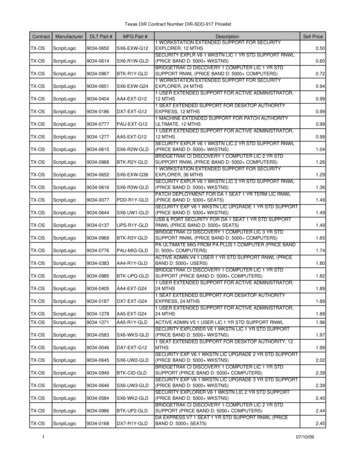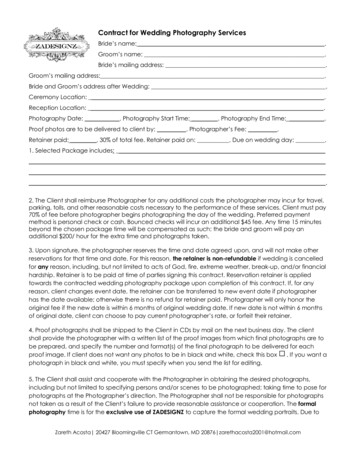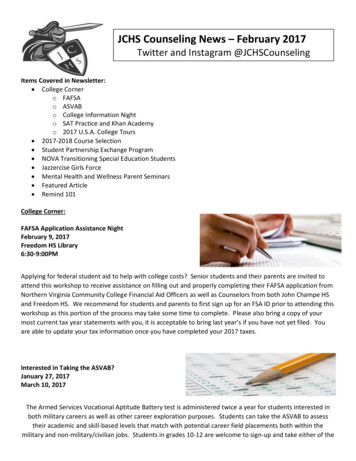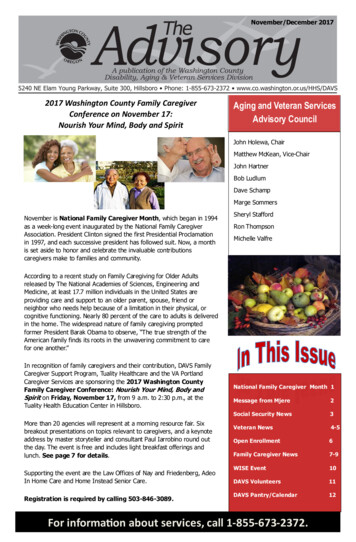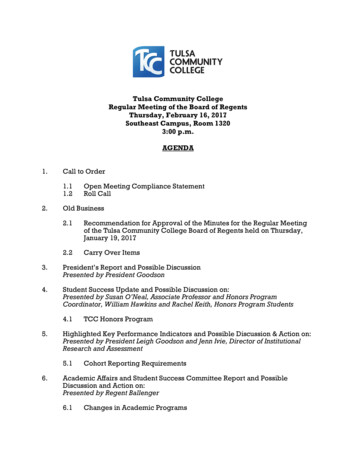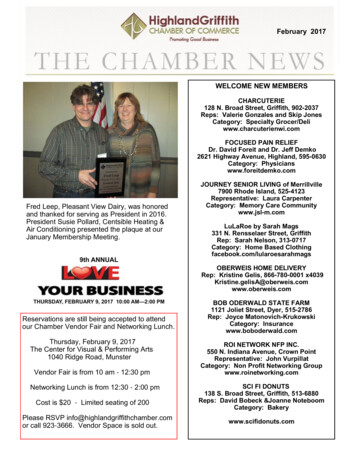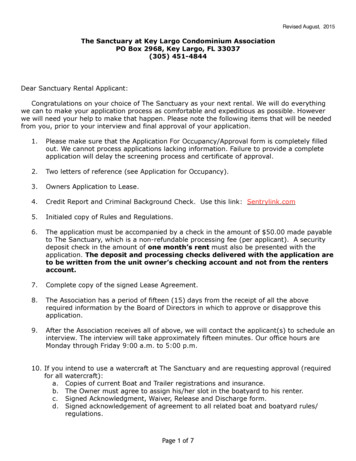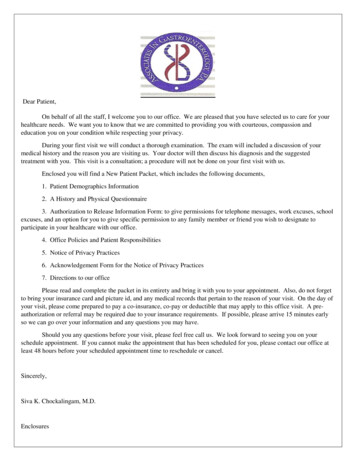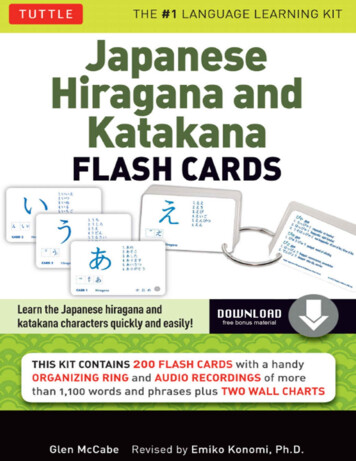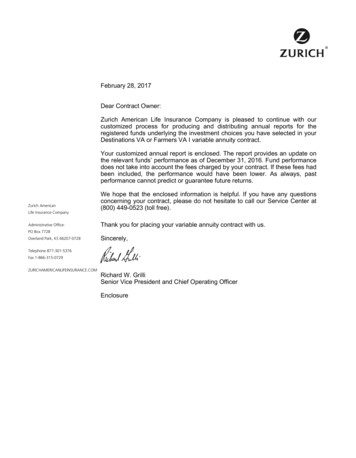
Transcription
February 28, 2017Dear Contract Owner:Zurich American Life Insurance Company is pleased to continue with ourcustomized process for producing and distributing annual reports for theregistered funds underlying the investment choices you have selected in yourDestinations VA or Farmers VA I variable annuity contract.Your customized annual report is enclosed. The report provides an update onthe relevant funds’ performance as of December 31, 2016. Fund performancedoes not take into account the fees charged by your contract. If these fees hadbeen included, the performance would have been lower. As always, pastperformance cannot predict or guarantee future returns.Zurich AmericanLife Insurance CompanyAdministrative Office:We hope that the enclosed information is helpful. If you have any questionsconcerning your contract, please do not hesitate to call our Service Center at(800) 449-0523 (toll free).Thank you for placing your variable annuity contract with us.PO Box 7728Overland Park, KS 66207-0728Sincerely,Telephone 877-301-5376Fax rd W. GrilliSenior Vice President and Chief Operating OfficerEnclosure
IMPORTANT NOTICE REGARDING CHANGE IN INVESTMENT POLICYSUPPLEMENT TO THE CURRENTLY EFFECTIVE SUMMARY PROSPECTUSESDeutsche Large Cap Value VIPEffective on or about May 1, 2017, each summary prospectus is supplemented as follows:Deutsche Large Cap Value VIP will be renamed Deutsche CROCI U.S. VIP.The following information replaces the first two sentences of the “Main investments” disclosure contained under the “PRINCIPAL INVESTMENT STRATEGY” section of the fund’s summary prospectus.Main investments. Under normal circumstances, the fund invests at least 80% of net assets, plus the amount of anyborrowings for investment purposes, in common stocks issued by US companies.Please Retain This Supplement for Future ReferenceJanuary 18, 2017PROSTKR-764
SUPPLEMENT TO THE CURRENTLY EFFECTIVE SUMMARY PROSPECTUSESDeutsche Large Cap Value VIPThe following information replaces similar disclosure contained under the “PRINCIPAL INVESTMENT STRATEGY” section ofthe fund’s summary prospectus.Main investments. Under normal circumstances, the fundinvests at least 80% of net assets, plus the amount of anyborrowings for investment purposes, in common stocks andother equity securities of large US companies that are similarin size to the companies in the Russell 1000 Value Indexand that portfolio management believes are undervalued. Whilethe market capitalization range of the Russell 1000 ValueIndex changes throughout the year, as of June 30, 2016, themarket capitalization range of the Russell 1000 Value Indexwas between approximately 1.48 billion and 515.59 billion.Companies are selected for the fund’s portfolio using theCash Return on Capital Invested (CROCI ) strategy as theprimary factor, among other factors. Portfolio managementwill select stocks from among the largest US companies whichare under CROCI coverage at any given time (while thenumber of companies under CROCI coverage will vary, asof September 30, 2016, approximately 345 companies wereunder CROCI coverage). Approximately 40 companies areidentified from the selection universe for investment, though,at times, the number of stocks held may be higher or lowerthan 40 stocks at the discretion of portfolio management oras a result of corporate actions, mergers or other events.Companies are selected from the following economic sectorsclassified in accordance with the Global Industry Classification Standard (GICS): Consumer Discretionary, ConsumerStaples, Energy, Financials, Health Care, Information Technology, Industrials, Materials, Telecommunications Servicesand Utilities.Management process. Portfolio management will select stocksof companies that it believes offer economic value, utilizingthe CROCI strategy as the primary factor, among other factors.The CROCI strategy is an investment process based on aproprietary valuation technique that attempts to understandthe value of a company by converting financial statementdata into a set of economic inputs that are used to calculatea valuation metric called the CROCI Economic Price Earnings Ratio which is comparable across markets, sectors andstocks. The CROCI Economic Price Earnings Ratio seeksto measure the “real” economic value rather than the“accounting” value of a company’s invested capital, and theeconomic returns thereof. Portfolio management believesthat, over time, companies with more favorable financial metrics,including CROCI Economic Price Earnings Ratios, will outperform other companies.In selecting stocks, portfolio management measures economicvalue using the CROCI Economic Price Earnings Ratio andmay adjust this by factors such as stock price volatility, asdetermined by the CROCI Investment Strategy and Valuation Group. The CROCI Investment Strategy and ValuationGroup may provide other CROCI valuation metrics whichportfolio management may use in addition to the CROCI Economic Price Earnings Ratio. All CROCI financial metricsmay be adjusted from time to time. Portfolio managementmay also use factors other than the CROCI strategy in selectinginvestments.The fund’s portfolio is reviewed periodically and adjusted inaccordance with the CROCI strategy’s rules. Portfolio management actively manages portfolio changes in an attempt toreduce market impact and transaction costs and to managethe portfolio with tax efficiency in mind.The following disclosure is added under the “MAIN RISKS” section of the fund’s summary prospectus:CROCI risk. The fund will be managed using the CROCI Investment Process which is based on portfolio management’s belief that, over time, stocks which display morefavorable financial metrics (for example, the CROCI Economic P/E Ratio) as generated by this process may outperform stocks which display less favorable metrics. This premisemay not prove to be correct and prospective investors shouldevaluate this assumption prior to investing in the fund.January 18, 2017PROSTKR-742The calculation of financial metrics used by the fund (suchas, among others, the CROCI Economic P/E Ratio) are determined by the CROCI Investment Strategy and ValuationGroup using publicly available information. This publicly available information is adjusted based on assumptions made bythe CROCI Investment Strategy and Valuation Group that,subsequently, may prove not to have been correct. As financial metrics are calculated using historical information, therecan be no guarantee of the future performance of theCROCI strategy.
All disclosure and references in each fund’s prospectus to “Foreign investment risk” and “Active trading risk” are herebydeleted.The following disclosure is added under the “AVERAGE ANNUALTOTAL RETURNS” sub-heading of the “PAST PERFORMANCE”section of the fund’s summary prospectus.Effective on or before October 3, 2016, the Standard & Poor’s(S&P) 500 Index replaced the Russell 1000 Value Index asthe comparative broad-based securities market index becausethe Advisor believes that the Standard & Poor’s (S&P) 500Index more closely reflects the fund’s overall investments.The following information replaces the existing disclosure contained under the “Portfolio Manager(s)” sub-heading of the“MANAGEMENT” section of the fund’s summary prospectus.Di Kumble, CFA, Managing Director. Portfolio Manager ofthe fund. Began managing the fund in 2016.John Moody, Vice President. Portfolio Manager of the fund.Began managing the fund in 2016.Please Retain This Supplement for Future ReferenceJanuary 18, 2017PROSTKR-7422
Summary Prospectus May 1, 2016Deutsche Large Cap Value VIPClassABefore you invest, you may want to review the fund’s prospectus, which contains more information about the fund and its risks.You can findthe fund’s prospectus, Statement of Additional Information and other information about the fund online at deutschefunds.com/vipros.You canalso get this information at no cost by e-mailing a request to service@db.com, calling (800) 728-3337 or by contacting your insurance company.The prospectus and Statement of Additional Information, both dated May 1, 2016, as supplemented, are incorporated by reference into thisSummary Prospectus.return each year and that the fund’s operating expenses(including one year of capped expenses in each period)remain the same. This example does not reflect any feesor sales charges imposed by a variable contract for whichthe fund is an investment option. If they were included,your costs would be higher.INVESTM ENT O B J E CT IV EThe fund seeks to achieve a high rate of total return.F EES AND EXPE N S E S O F T H E F UN DThis table describes the fees and expenses you may pay ifyou buy and hold shares of the fund. This information doesnot reflect fees associated with the separate account thatinvests in the fund or any variable life insurance policy orvariable annuity contract for which the fund is an investment option. These fees will increase expenses.Although your actual costs may be higher or lower, basedon these assumptions your costs would be:1 Year3 Years5 Years10 Years 77 246 430 963SHAREHOLDER F E E S(paid directly from your investment)NonePO RTFO LIO TURNOVERThe fund pays transaction costs, such as commissions,when it buys and sells securities (or “turns over” its portfolio). A higher portfolio turnover may indicate highertransaction costs. These costs are not reflected in annualfund operating expenses or in the expense example, butcan affect the fund’s performance.ANNUAL FUND O P E R AT IN G E X P E N S E S(expenses that you pay each year as a % of the value of your investment)Management feeDistribution/service (12b-1) fees0.64NoneOther expenses0.14Total annual fund operating expenses0.78Fee waiver/expense reimbursement0.03Total annual fund operating expenses after fee waiver/expense reimbursement0.75Portfolio turnover rate for fiscal year 2015: 121%.PRIN CIPAL IN VESTMEN T STRATEGYMain Investments. Under normal circumstances, the fundinvests at least 80% of net assets, plus the amount ofany borrowings for investment purposes, in commonstocks and other equity securities of large US companiesthat are similar in size to the companies in the Russell1000 Value Index and that portfolio management believesare undervalued. These are typically companies that havebeen sound historically, but are temporarily out of favorwith the market. While the market capitalization range ofthe Russell 1000 Value Index changes throughout theyear, as of the most recent reconstitution date of the indexJune 26, 2015 the market capitalization range of theRussell 1000 Value Index was between 252 million and 367.19 billion.The Advisor has contractually agreed through April 30,2017 to waive its fees and/or reimburse certain operatingexpenses of the fund to the extent necessary to maintain the fund’s total annual operating expenses (excludingcertain expenses such as extraordinary expenses, taxes,brokerage and interest expenses) at a ratio no higher than0.75% for Class A shares. The agreement may only beterminated with the consent of the fund’s Board.EXAM PLEThis Example is intended to help you compare the cost ofinvesting in the fund with the cost of investing in othermutual funds. The Example assumes that you invest 10,000 in the fund for the time periods indicated and thenredeem all of your shares at the end of those periods. TheExample also assumes that your investment has a 5%1
intended to be a complete investment program. An investment in the fund is not a deposit of a bank and is notinsured or guaranteed by the Federal Deposit InsuranceCorporation or any other governmental agency.Although the fund can invest in stocks of any economicsector (which is comprised of two or more industries), attimes it may emphasize certain sectors, even investingmore than 25% of total assets in any one sector. The fundmay invest up to 20% of net assets in foreign securities.Stock market risk. When stock prices fall, you shouldexpect the value of your investment to fall as well. Stockprices can be hurt by poor management on the part of thestock’s issuer, shrinking product demand and other business risks. These may affect single companies as well asgroups of companies. In addition, movements in financialmarkets may adversely affect a stock’s price, regardless ofhow well the company performs. The market as a wholemay not favor the types of investments the fund makes,which could affect the fund’s ability to sell them at anattractive price. To the extent the fund invests in aparticular capitalization or sector, the fund’s performancemay be affected by the general performance of thatparticular capitalization or sector.Management process. Portfolio management employsa “relative value process” that seeks to identify securitiesthat have strong fundamentals but are at the lower endof their valuation range. Current valuations are comparedto historical valuations to make these determinations.Portfolio management seeks to achieve superior long-termrisk-adjusted returns by:䡲 Exploiting market inefficiencies through a bottom-up,relative value, research-driven approach䡲 Identifying companies with leading market positions thatare selling below long-term valuation levels䡲 Analyzing business models and market and issuer financial factors䡲 Integrating risk management into the stock selectionand portfolio construction processesTypically, portfolio management expects to invest in 60-80holdings, drawing on an analysis of economic outlooksfor various sectors and industries.Security selection risk. The securities in the fund’s portfolio may decline in value. Portfolio management could bewrong in its analysis of industries, companies, economictrends, the relative attractiveness of different securities orother matters.Portfolio management will normally sell a stock when itbelieves the stock’s reward to risk ratio has diminished, thestock’s fundamental factors have changed, other investments offer better opportunities or in the course ofadjusting the fund’s emphasis on a given industry.Value investing risk. As a category, value stocks mayunderperform growth stocks (and the stock market as awhole) over any period of time. In addition, value stocksselected for investment by portfolio management may notperform as anticipated.Derivatives. Portfolio management generally may usefutures contracts, which are a type of derivative (a contractwhose value is based on, for example, indices, currencies or securities), as a substitute for direct investment ina particular asset class, to keep cash on hand to meetshareholder redemptions or other needs while maintainingexposure to the stock market.Focus risk. To the extent that the fund focuses its investments in particular industries, asset classes or sectorsof the economy, any market price movements, regulatoryor technological changes, or economic conditions affectingcompanies in those industries, asset classes or sectorsmay have a significant impact on the fund’s performance.Derivatives risk. Risks associated with derivatives mayinclude the risk that the derivative is not well correlatedwith the security, index or currency to which it relates; therisk that derivatives may result in losses or missed opportunities; the risk that the fund will be unable to sell thederivative because of an illiquid secondary market; the riskthat a counterparty is unwilling or unable to meet its obligation; and the risk that the derivative transaction couldexpose the fund to the effects of leverage, which couldincrease the fund’s exposure to the market and magnifypotential losses.The fund may also use other types of derivatives (i) forhedging purposes; (ii) for risk management; (iii) fornon-hedging purposes to seek to enhance potential gains;or (iv) as a substitute for direct investment in a particularasset class or to keep cash on hand to meet shareholderredemptions.Securities Lending. The fund may lend securities (up toone-third of total assets) to approved institutions.Active Trading. The fund may trade actively. This couldraise transaction costs (thus lowering returns).Counterparty risk. A financial institution or othercounterparty with whom the fund does business, or thatunderwrites, distributes or guarantees any investments orcontracts that the fund owns or is otherwise exposed to,may decline in financial health and become unable tohonor its commitments. This could cause losses for thefund or could delay the return or delivery of collateral orother assets to the fund.MAIN RISKSThere are several risk factors that could hurt the fund’sperformance, cause you to lose money or cause the fund’sperformance to trail that of other investments. The fundmay not achieve its investment objective, and is not2Deutsche Large Cap Value VIPSummary ProspectusMay 1, 2016
account that invests in the fund or any variable life insurance policy or variable annuity contract for which the fundis an investment option. These fees will reduce returns.Liquidity risk. In certain situations, it may be difficult orimpossible to sell an investment and/or the fund may sellcertain investments at a price or time that is not advantageous in order to meet redemption requests or othercash needs. Unusual market conditions, such as an unusually high volume of redemptions or other similar conditionscould increase liquidity risk for the fund.CALENDAR YEAR TOTAL RETURNS (%) (CLASS A)6040Securities lending risk. Any decline in the value of a portfolio security that occurs while the security is out on loanis borne by the fund and will adversely affect performance.Also, there may be delays in recovery of securities loanedor even a loss of rights in the collateral should theborrower of the securities fail financially while holding thesecurity.2030.8925.3715.41 oreign investment risk. The fund faces the risksinherent in foreign investing. Adverse political, economicor social developments could undermine the value of thefund’s investments or prevent the fund from realizing thefull value of its investments. Financial reporting standardsfor companies based in foreign markets differ from thosein the US. Additionally, foreign securities markets generallyare smaller and less liquid than US markets. To the extentthat the fund invests in non-US dollar denominated foreignsecurities, changes in currency exchange rates may affectthe US dollar value of foreign securities or the income orgain received on these securities.20072008Best QuarterWorst urnsPeriod ending15.86%-22.50%June 30, 2009December 31, 2008-7.52%March 31, 2016AVERAGE ANNUAL TOTAL RETURNS(For periods ended 12/31/2015 expressed as a %)Class ARussell 1000 ValueIndex (reflects no deduction for fees, expensesor taxes)Pricing risk. If market conditions make it difficult to valuesome investments, the fund may value these investmentsusing more subjective methods, such as fair value pricing.In such cases, the value determined for an investmentcould be different from the value realized upon such investment’s sale. As a result, you could pay more than themarket value when buying fund shares or receive less thanthe market value when selling fund 878.175.50-3.8311.276.16MAN AG EMEN TInvestment AdvisorDeutsche Investment Management Americas Inc.Portfolio Manager(s)Deepak Khanna, CFA, Managing Director. Lead PortfolioManager of the fund. Began managing the fund in 2014.Active trading risk. The fund may trade actively. This couldraise transaction costs (thus lowering returns).Operational and technology risk. Cyber-attacks, disruptions, or failures that affect the fund’s service providers orcounterparties, issuers of securities held by the fund, orother market participants may adversely affect the fundand its shareholders, including by causing losses for thefund or impairing fund operati
Zurich American Life Insurance Company Administrative Office: PO Box 7728 Overland Park, KS 66207-0728 Telephone 877-30

